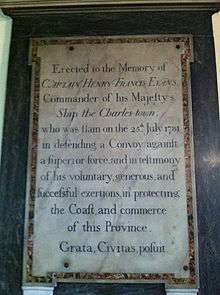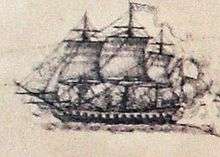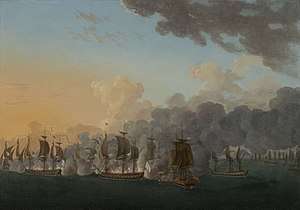Action of 21 July 1781
The Action of 21 July 1781[1] was a naval skirmish off the harbor of Spanish River, Cape Breton, Nova Scotia (present-day Sydney, Nova Scotia), during the American Revolution. Two French Navy frigates, led by Admiral Latouche Tréville and La Pérouse, engaged a convoy of 18 British ships and their escorts from the Royal Navy. The two French frigates captured two of the British escorts while the remainder of the British convoy escaped.
Background
A possible motive for the French attack was to make advances to reclaim Louisburg, a strategic fortress which the British had seized during the French and Indian War.[2][3]
Action
The convoy, which consisted of eighteen ships, including nine coal-transporting and four supply ships, was bound for Spanish River on Cape Breton Island to pick up coal for delivery to Halifax.[4][5] The escorting ships were the frigate Charlestown (28); the sloops Allegiance (24) and Vulture (20); an armed transport Vernon (14); and another small armed ship Jack (14).[4]
Two French frigates Astrée (38), commanded by La Pérouse, and Hermione (34), commanded by Latouche Tréville, attacked the convoy.[5] The French severely damaged Charlestown, which lost its mainmast and a number of its officers, including Captain Francis Evans. The French also significantly damaged Jack, which also lost its captain, and subsequently struck her colors. The engagement ended at nightfall. Captain Rupert George of Vulture led the damaged escorts into a safe harbor.[6] Six French and seventeen British sailors were killed.[7]
While the British escort was severely damaged, the convoy was still able to pick up a load of coal at Spanish River and deliver it to Halifax.[4] The French captured the British ship Thorn off Halifax Harbor, along with three merchantmen, which they brought back to Boston. On October 6, the Jack was taken to Halifax and later released under the British command of R. P. Tonge (son of W. Tonge), who, after a brief skirmish with 2 American Privateers in Canso, took Americana prisoners to Quebec.[8] The following year, the British recaptured Jack in the Naval battle off Halifax.
Aftermath
The French commanders would go on to achieve further acclaim and recognition for their performance. Latouche Tréville became an admiral and was named a hero of the Napoleonic war. La Pérouse later became a famous explorer.
American Privateers attacked British mining on Cape Breton throughout the war.[9]
Commemorations

The encounter was painted by Auguste-Louis de Rossel de Cercy, and is on display at the Musée Nationale de la Marine in Rochefort.
Gallery
 French frigate Astrée at the battle off Cape Breton
French frigate Astrée at the battle off Cape Breton French frigate Hermione at the battle off Cape Breton
French frigate Hermione at the battle off Cape Breton Hermione in combat off Cape Breton. Combat Naval A La Hauteur De Louisbourg by Auguste-Louis de Rossel de Cercy.
Hermione in combat off Cape Breton. Combat Naval A La Hauteur De Louisbourg by Auguste-Louis de Rossel de Cercy. Description of the order of battle by Lieutenant de Frégate auxillaire Mullon, who was aboard the Hermione the day of the battle.
Description of the order of battle by Lieutenant de Frégate auxillaire Mullon, who was aboard the Hermione the day of the battle.
See also
Citations
- ↑ (French: Combat naval en vue de Louisbourg, or Combat naval à la hauteur de Louisbourg)
- ↑ History of the origin, formation, and adoption of the Constitution of the United States George Ticknor Curtis, p.156
- ↑ Brian Douglas Tennyson and Roger Flynn Sarty (2002), Guardian of the Gulf, University of Toronto Press. Pages 18-19
- 1 2 3 Frigates and Foremasts: The North American Squadron in Nova Scotia Waters, 1745- 1815 by Julian Gwyn p.72-3
- 1 2 Ashore and afloat by Julian Gwyn p.155
- ↑ "Battle off Spanish River". www.awiatsea.com. Retrieved 2016-12-01.
- ↑ http://www.awiatsea.com/incidents/1781-07-21%20Battle%20off%20Spanish%20River.html
- ↑ https://archive.org/stream/ahistorynovasco01murdgoog#page/n639/mode/1up
- ↑ Timothy Hierlihy and his times
References
- Gwyn, Julian, Ashore and afloat
- Gwyn, Julian (2004), Frigates and Foremasts: The North American Squadron in Nova Scotia. Waters, 1745–1815, UBC Press.
- Murdoch, Beamish, A History of Nova-Scotia, or Acadie.
